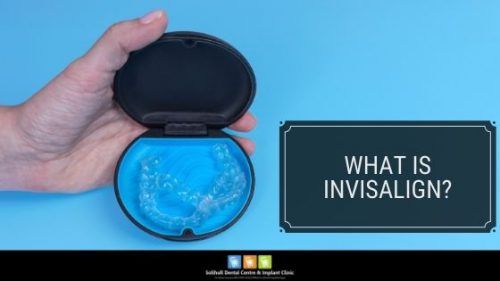
Our teeth are not just meant for eating. They have another vital role to play – they are the most crucial component of our facial aesthetics. While perfectly aligned teeth make us look charming and attractive, people with crooked or misaligned teeth are often perceived as unattractive and less intelligent. If you are concerned about your misaligned teeth, this article will explain how you can get a rockstar smile by getting your teeth straightened with Invisalign.
Invisalign Versus Braces – A Comparison
If you are thinking about orthodontic treatment, most likely, you will have two treatment options in mind; traditional metal braces and the Invisalign aligner. So, which option is the best for you? You can only decide once you know the differences and similarities between both the orthodontic options.
Perhaps, the most noticeable difference between the braces and the aligners is that while the metal braces are highly conspicuous, Invisalign aligners are made from a transparent material – making them virtually invisible when you wear them.
Similarly, braces remain fixed to your teeth while the aligners are removable. Also, since the brackets are bonded to your teeth with an adhesive, your dentist will ask you not to eat hard or sticky foods – as doing so may result in the dislodgment of your brackets. On the other hand, Invisalign aligners can be removed whenever you want to eat or drink something.
Since the Invisalign aligners are removable, you can take them off while brushing and flossing to achieve optimal oral hygiene, unlike the metal braces, which create difficulties in teeth cleaning, especially the teeth’ tight spaces.
In terms of the range of treatment, metal braces can be used for treating even the most complicated orthodontic cases. On the other hand, Invisalign aligners are generally suitable for mild to moderate orthodontic problems.
Can You Get Invisalign For Only Top Teeth?
Generally, orthodontic treatment with aligners involves wearing a set of upper and lower aligners. Wearing both the upper and lower aligners ensures that the alignment of the top and bottom teeth is achieved harmoniously, and symmetrical results are achieved. However, in cases where there is a mild misalignment in the upper or the lower jaw, your dentist may ask you to wear aligners only on the affected jaw.
Please note that this is not done routinely, and dentists handle such situations on a case-to-case basis – depending on your individual dental needs. Before starting the treatment, your dentist will perform a detailed clinical examination of your teeth. He or she will also make a 3D digital scan of your teeth (Often using an Itero element scanner) to prepare a custom treatment plan for you. Only after thorough treatment planning, your Invisalign will let you know whether you need aligners in both jaws or one only.
How Long Does Invisalign Take?
Whether it’s the conventional fixed braces or the Invisalign aligners, treatment duration depends on various factors. The most crucial factor is the severity of the orthodontic problem. Typically, mild to moderate problems with tooth misalignment can be fixed within 8-12 months with Invisalign. However, it may take anywhere between 18-24 months for complete treatment when it comes to more complex or complicated orthodontic issues.
Another factor that affects the treatment time is patient compliance. Especially in removable aligners, many patients forget to wear them for the recommended duration, or they misplace or break them frequently. The manufacturers of Invisalign Clear Aligners recommend wearing your aligners for 22 hours each day for optimal results.
How Does Invisalign Move Teeth?
At the beginning of your treatment, your orthodontist will give a set of numbered aligners. You will be asked to wear an aligner set for about two weeks and then switch to the next set of aligners. Your dentist will design your aligners to exert gentle forces on your teeth to move them in the desired direction. The Invisalign aligners are made from a proprietary SmartTrack material, which ensures that they snugly fit around your teeth while remaining comfortable and moving your teeth as fast as possible – without causing pain or discomfort.
How Long Do You Have To Wear Invisalign?
Your dentist will ask you to continue to wear your aligners until all your teeth have been straightened. Depending on the complexity of your case, your orthodontic specialist may give you anywhere between six to forty-eight aligner sets. Once you have worn a set for fourteen days, you will be asked to switch to the next aligners. In this way, each aligner set will bring you one step closer to the goal – perfectly aligned and straight teeth.
Your orthodontic may reduce the treatment time by using special attachments with your aligners. Moreover, you can also shorten the duration of your treatment by adhering to your dentist’s instructions. Make sure you wear your aligners for a time duration determined by your doctor – removing them only for eating or brushing your teeth. In case you accidentally break or fracture your aligners, visit your orthodontist immediately to get a replacement so that it does not affect your treatment.
You must also take note that once your dentist has completed your active treatment with aligners, you may have to wear Viverra retainers for some time. According to the National Health Service (NHS), A retainer is a removable or fixed appliance used for consolidating your treatment – and ensuring that your teeth do not move back to their previous position.
Are you looking for a reliable and friendly dental practice to get your teeth straightened with Invisalign Clear Aligners in Solihull? Look no more! Our team of experienced dentists and Invisalign specialists prepare a customised treatment plan for you – to transform your smile – and give you a set of perfectly aligned, pearly-white, and healthy teeth that you can be genuinely proud of! So, what are you waiting for? Book an appointment with us today for a free consultation, and let us take care of all your dental problems.
Zubair Sacranie
Latest posts by Zubair Sacranie (see all)
- What To Do When Half Your Tooth Breaks Off? - 31st March, 2025
- Dental Implants in Solihull: Your Complete Guide - 28th January, 2025
- When Do Baby Teeth Fall Out and Adult Teeth Come In? - 1st December, 2024


